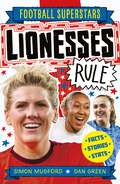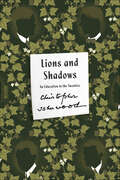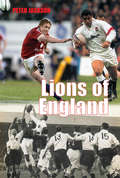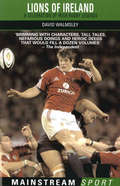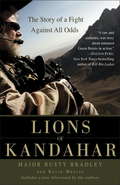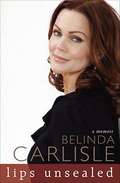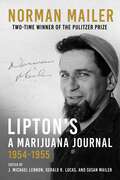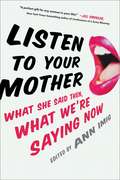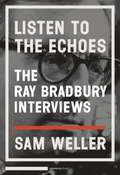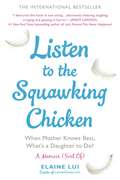- Table View
- List View
Lionel Richie (Centerstage)
by Howard Schroeder Teresa KoenigExamines the life of the Alabama musician and songwriter who gained prominence with the Commodores and went on to a highly successful solo career.
Lionel Richie: An Illustrated Biography
by David NathanAs a member of The Commodores, Lionel Richie wrote and performed 'Three Times A Lady', 'Easy' and many other great hits. As a solo artist, he has surpassed even these achievements with songs like 'Hello'.
Lionel Robbins
by Susan HowsonBy the time of his death the English economist Lionel Robbins (1898-1984) was celebrated as a 'renaissance man'. He made major contributions to his own academic discipline and applied his skills as an economist not only to practical problems of economic policy - with conspicuous success when he served as head of the economists advising the wartime coalition government of Winston Churchill in 1940-45 - and of higher education - the 'Robbins Report' of 1963 - but also to the administration of the visual and performing arts that he loved deeply. He was devoted to the London School of Economics, from his time as an undergraduate following active service as an artillery officer on the Western Front in 1917-18, through his years as Professor of Economics (1929-62), and his stint as chairman of the governors during the 'troubles' of the late 1960s. This comprehensive biography, based on his personal and professional correspondence and other papers, covers all these many and varied activities.
Lionel Trilling and Irving Howe: And Other Stories of Literary Friendship
by Edward AlexanderThis pioneering effort links history and personality, by pairing intellectual friends and foes, most notably Lionel Trilling and Irving Howe, but also Thomas Carlyle and John Stuart Mill, T.E. Lawrence and Bertrand Russell, and lesser known figures. The periods range from the early 1830s, when Carlyle and Mill discovered each other, to 1975, when Lionel Thrilling died and the relationship with Howe ended. The essay that gives this volume its title is also the most ambitious. Alexander examines Trilling and Howe in relation to one another, as well as their comparative reactions to the Holocaust. He explores their participation in the fierce disputes of the fifties over the relationship between literature and society, and their perspectives on the turmoil of the American sixties. The chapter on the friendships (and ex-friendships) of Carlyle and Mill, Lawrence and Russell, views their stories against the background of the modern conflict between reason and feeling, positivism and imagination. But Alexander avoids viewing each pair of friends as counterparts. Though relationships may have begun in adversity, they sometimes developed into friendships. As a young woman, George Eliot dismissed Jews as candidates for 'extermination', but her friendship with the Talmudic scholar Emanuel Deutsch changed her into one of the major Judeophiles of the Victorian period. And the quartet of Thomas Carlyle, J. S. Mill, D. H. Lawrence and Bertrand Russell shows how quickly-formed literary friendships, especially those based on the hunger for disciples, sometimes dissolve into ex-friendships. This volume reveals new perspectives on leading literary figures and their relationships, and shows how personal friendship influences art.
Lioness - My Journey to Glory: Winner of the Sunday Times Sports Book Awards Autobiography of the Year 2023
by Beth MeadThe Sunday Times bestseller and winner of the Sunday Times Sports Book Awards Autobiography of the Year 2023Fully updated paperback edition, with two new chaptersBeth Mead is one of the world's most talented footballers - Golden Boot winner and Player of the Tournament at the UEFA Euro 2022, England Player of the Year 2021-22, Arsenal Player of the Season 2021-22, and nominee for the 2022 Ballon d'Or. But long before this, Beth was just an ordinary kid from Hinderwell, North Yorkshire who wanted to play football. Now, Beth shares the challenges that shaped her, what she faced on the journey to the top, and the life events that made her stronger - from being dropped from the England squad and receiving devastating family news, to finding her best form under the guidance of Jonas Eidevall and Sarina Wiegman. Filled with positive lessons and an exclusive account of England's triumphant Euros campaign, Beth offers readers of all ages a heartfelt, behind-the-scenes look into her remarkable journey to glory. Empowering, inspirational and honest, this is Beth's story.This paperback edition has been fully updated to include the details of the 2022-23 season, Beth's ACL injury and her recovery, her thoughts on the 2023 Women's World Cup, as well as overcoming devastating personal challenges and how this has made her even stronger.
Lioness - My Journey to Glory: Winner of the Sunday Times Sports Book Awards Autobiography of the Year 2023
by Beth MeadThe Sunday Times bestseller and winner of the Sunday Times Sports Book Awards Autobiography of the Year 2023Fully updated paperback edition, with two new chaptersBeth Mead is one of the world's most talented footballers - Golden Boot winner and Player of the Tournament at the UEFA Euro 2022, England Player of the Year 2021-22, Arsenal Player of the Season 2021-22, and nominee for the 2022 Ballon d'Or. But long before this, Beth was just an ordinary kid from Hinderwell, North Yorkshire who wanted to play football. Now, Beth shares the challenges that shaped her, what she faced on the journey to the top, and the life events that made her stronger - from being dropped from the England squad and receiving devastating family news, to finding her best form under the guidance of Jonas Eidevall and Sarina Wiegman. Filled with positive lessons and an exclusive account of England's triumphant Euros campaign, Beth offers readers of all ages a heartfelt, behind-the-scenes look into her remarkable journey to glory. Empowering, inspirational and honest, this is Beth's story.This paperback edition has been fully updated to include the details of the 2022-23 season, Beth's ACL injury and her recovery, her thoughts on the 2023 Women's World Cup, as well as overcoming devastating personal challenges and how this has made her even stronger.
Lioness: Golda Meir and the Nation of Israel
by Francine KlagsbrunThe definitive biography of the iron-willed leader, chain-smoking political operative, and tea-and-cake-serving grandmother who became the fourth prime minister of Israel Golda Meir was a world figure unlike any other. Born in tsarist Russia in 1898, she immigrated to America in 1906 and grew up in Milwaukee, where from her earliest years she displayed the political consciousness and organizational skills that would eventually catapult her into the inner circles of Israel's founding generation. Moving to mandatory Palestine in 1921 with her husband, the passionate socialist joined a kibbutz but soon left and was hired at a public works office by the man who would become the great love of her life. A series of public service jobs brought her to the attention of David Ben-Gurion, and her political career took off. Fund-raising in America in 1948, secretly meeting in Amman with King Abdullah right before Israel's declaration of independence, mobbed by thousands of Jews in a Moscow synagogue in 1948 as Israel's first representative to the USSR, serving as minister of labor and foreign minister in the 1950s and 1960s, Golda brought fiery oratory, plainspoken appeals, and shrewd deal-making to the cause to which she had dedicated her life—the welfare and security of the State of Israel and its inhabitants. As prime minister, Golda negotiated arms agreements with Richard Nixon and Henry Kissinger and had dozens of clandestine meetings with Jordan's King Hussein in the unsuccessful pursuit of a land-for-peace agreement with Israel's neighbors. But her time in office ended in tragedy, when Israel was caught off guard by Egypt and Syria's surprise attack on Yom Kippur in 1973. Analyzing newly available documents from Israeli government archives, Francine Klagsbrun looks into whether Golda could have prevented that war and whether in its darkest days she contemplated using nuclear force. Resigning in the war's aftermath, she spent her final years keeping a hand in national affairs and bemusedly enjoying international acclaim. Klagsbrun's superbly researched and masterly recounted story of Israel's founding mother gives us a Golda for the ages.
Lionesses Rule (Football Superstars #25)
by Simon MugfordWho isn't a fan of the Lionesses?! Currently ranked among the world's top five, the current team have grown into a powerhouse and claimed their place as the best in Europe on home soil in that thrilling final at Wembley in the summer of 2022!Football Superstar's dynamic duo, Dan and Simon, were glued to their screens too, and are now here to tell you the story of how the Lionesses became so mighty. They look back at how the sport rose from a 50-year ban to becoming one of the nation's most eagerly watched games. Along the way you'll learn about the legendary players, managers, matches, songs, fans and, of course, all the awesome stats that tell the story of the Lionesses' glory trail on the international stage.Football Superstars is a series aimed at building a love of reading from a young age, with fun cartoons, inspirational stories, a simple narrative style and a cast of characters chipping in with quotes, jokes and comments.
Lionesses Rule (Football Superstars #26)
by Simon MugfordWho isn't a fan of the Lionesses?! Currently ranked among the world's top five, the current team have grown into a powerhouse and claimed their place as the best in Europe on home soil in that thrilling final at Wembley in the summer of 2022!Football Superstar's dynamic duo, Dan and Simon, were glued to their screens too, and are now here to tell you the story of how the Lionesses became so mighty. They look back at how the sport rose from a 50-year ban to becoming one of the nation's most eagerly watched games. Along the way you'll learn about the legendary players, managers, matches, songs, fans and, of course, all the awesome stats that tell the story of the Lionesses' glory trail on the international stage.Football Superstars is a series aimed at building a love of reading from a young age, with fun cartoons, inspirational stories, a simple narrative style and a cast of characters chipping in with quotes, jokes and comments.
Lionheart
by Graham Thomas Richard HibbardWhen Lions and Wales rugby star Richard Hibbard crashed into George Smith under a clear night sky in Australia, it felt as though the tremors might have rocked Sydney Harbour Bridge. Smith was the 'Mr Indestructible' of Australian rugby, yet he was helped off the pitch. Hooker Hibbard simply shook his trademark blond locks and carried on helping the Lions earn their 2013 series victory. Soon, pictures of "Hibbz" celebrating in the dressing room with James Bond actor Daniel Craig were being beamed around the world. In Lionheart the Ospreys star reflects on his long and often rocky road to the top of world rugby: from his roots in Port Talbot, to his stint with rugby league club Aberavon Fighting Irish, to fighting back from countless serious injuries.
Lions and Shadows: An Education in the Twenties (Fsg Classics Ser.)
by Christopher IsherwoodA witty, appealing, and often outrageous portrait of some of the twentieth century's most influential and creative mindsSubtitled "An Education in the Twenties," Lions and Shadows blends autobiography and fiction to describe the inner life of a writer evolving from precocious schoolboy to Cambridge dropout-at-large in London's bohemia. It contains thinly veiled portraits of Christopher Isherwood's contemporaries W. H. Auden, Edward Upward, and Stephen Spender, whose intimate friendships and cult of rebellion shaped the literary identity of England in the 1930s. Witty and outrageous, Isherwood pokes fun at the stars of his generation, above all himself, even as he testifies to their unique early gifts.
Lions of England
by Peter JacksonEngland has contributed some of the greatest players and most colourful characters to the rich history of the Lions, and never more so than in recent years. During the course of little more than a decade, a golden era for the Red Rose yielded four Grand Slams en route to the thrilling climax of the World Cup victory in Sydney, a triumph which has catapulted some of the side's stars to a higher plane in the nation's affections. It is not surprising, therefore, that English players have dominated the last four Lions tours in a way which none of the home countries has done before. Lions of England presents the country's most famous players in a series of revealing portraits, each telling a fascinating story woven around monumental Test matches. Rich in previously untold anecdote and humour, these accounts illustrate the lives and times of the greats spanning three-quarters of a century - from one pre-war knight of the realm, Carl Aarvold, to a more recent one, Clive Woodward. All the evocative names of English rugby are featured here, from Dickie Jeeps to Martin Johnson, Jeff Butterfield to Jason Robinson, Dean Richards to Lawrence Dallaglio. Other chapters are devoted to Peter Jackson (a rather better player than the author), John Pullin, Roger Uttley, Fran Cotton, David Duckham, Bill Beaumont, Peter Wheeler, Jeremy Guscott, Rob Andrew, Jason Leonard and, of course, Jonny Wilkinson.Peter Jackson, the Daily Mail's award-winning rugby writer, has drawn on all his experience and eye for the unusual to give the reader an insight into what makes these talented players tick as people, the early influences which shaped their careers and the momentous events which made them household names. Bang up to date with the inclusion of the summer 2005 series against the All Blacks and a comprehensive records appendix, Lions of England is sure to inform and entertain rugby lovers of every generation in equal measure.
Lions of Ireland: A Celebration of Irish Rugby Legends
by David WalmsleyLook for a Lions legend and the chances are you will find an Irishman. Throughout the touring team's history, the heroes of Irish rugby have been at the heart of the Lions' finest hours - on and off the pitch. Look at the Lions record books and you will find Irishmen at the top of almost every list, from Willie John McBride and Tony O'Reilly to Ronnie Dawson. No nation has provided more leaders of the Lions. In Lions of Ireland, these greats tell their stories of life on some of the longest, hardest roads in sport. Those featured include world-class players and characters who have contributed to Lions folklore, such as Karl Mullen, Jack Kyle, Fergus Slattery, Tom Kiernan, Mike Gibson and Syd Millar - and the account is brought up to date with contributions from the likes of Keith Wood. This book includes a complete reference section featuring every Irish player to have represented the Lions in Tests since the first united tour of 1910. It recalls the powerful personalities and relives the most dramatic deeds in the Lions' long history - from the 1971 groundbreaking triumph against the All Blacks and success against the odds in South Africa in 1997 to the 2005 tour of New Zealand.
Lions of Kandahar: The Story of a Fight Against All Odds
by Rusty Bradley Kevin MaurerOne of the most critical battles of the Afghan War is now revealed as never before. Lions of Kandahar is an inside account from the unique perspective of an active-duty U.S. Army Special Forces commander, an unparalled warrior with multiple deployments to the theater who has only recently returned from combat there.Southern Afghanistan was slipping away. That was clear to then-Captain Rusty Bradley as he began his third tour of duty there in 2006. The Taliban and their allies were infiltrating everywhere, poised to reclaim Kandahar Province, their strategically vital onetime capital. To stop them, the NATO coalition launched Operation Medusa, the largest offensive in its history. The battlefield was the Panjwayi Valley, a densely packed warren of walled compounds that doubled neatly as enemy bunkers, lush orchards, and towering marijuana stands, all laced with treacherous irrigation ditches. A mass exodus of civilians heralded the carnage to come.Dispatched as a diversionary force in support of the main coalition attack, Bradley's Special Forces A-team and two others, along with their longtime Afghan Army allies, watched from across the valley as the NATO force was quickly engulfed in a vicious counterattack. Key to relieving it and calling in effective air strikes was possession of a modest patch of high ground called Sperwan Ghar. Bradley's small detachment assaulted the hill and, in the midst of a savage and unforgettable firefight, soon learned they were facing nearly a thousand seasoned fighters--from whom they seized an impossible victory.Now Bradley recounts the whole remarkable story as it actually happened. The blistering trek across Afghanistan's infamous Red Desert. The eerie traces of the elusive Taliban. The close relations with the Afghan people and army, a primary mission focus. Sperwan Ghar itself: unremitting waves of fire from machine guns and rocket-propelled grenades; a targeted truck turned into an inferno; the death trap of a cut-off compound. Most important: the men, Americans and Afghans alike--the "shaky" medic with nerves of steel and a surgeon's hands in battle; the tireless sergeant who seems to be everywhere at once; the soft-spoken intelligence officer with laser-sharp insight; the diminutive Afghan commander with a Goliath-sized heart; the cool maverick who risks all to rescue a grievously wounded comrade--each unique, all indelible in their everyday exercise of extraordinary heroism.From the Hardcover edition.
Lions of the West: Heroes and Villains of the Westward Expansion
by Robert MorganFrom Thomas Jefferson’s birth in 1743 to the California Gold Rush in 1849, America’s westward expansion comes to life in the hands of a writer fascinated by the way individual lives link up, illuminate one another, and collectively impact history. Jefferson, a naturalist and visionary, dreamed that the United States would stretch across the North American continent, from ocean to ocean. The account of how that dream became reality unfolds in the stories of Jefferson and nine other Americans whose adventurous spirits and lust for land pushed the westward boundaries: Andrew Jackson, John “Johnny Appleseed” Chapman, David Crockett, Sam Houston, James K. Polk, Winfield Scott, Kit Carson, Nicholas Trist, and John Quincy Adams. Their stories—and those of the nameless thousands who risked their lives to settle on the frontier, displacing thou- sands of Native Americans—form an extraordinary chapter in American history that led directly to the cataclysm of the Civil War. Filled with illustrations, portraits, maps, battle plans, notes, and time lines, Lions of the West is a richly authoritative biography of America—its ideals, its promise, its romance, and its destiny.
Lips Unsealed: A Memoir
by Belinda CarlisleThe women of the iconic eighties band the Go-Go's will always be remembered as they appeared on the back of their debut record: sunny, smiling, each soaking in her own private bubble bath with chocolates and champagne. The photo is a perfect tribute to the fun, irreverent brand of pop music that the Go-Go's created, but it also conceals the trials and secret demons that the members of the group - and, in particular, its lead singer, Belinda Carlisle - struggled with on their rise to stardom. Leaving her unstable childhood home at the age of eighteen, Belinda battled serious weight issues, having been teased for her pudginess throughout grade school, and grappled with her confusion about being deserted by her biological father as a child. This talented but misguided teen found solace in the punk rock world that so openly welcomed misfits - even though acceptance had its price. Not long after forming, the Go-Go's became queens of the L. A. punk scene - they sold out venues, attracted a fiercely loyal fan base, and outpartied almost every male band they toured with - and in the process kicked down the doors to the all-boys' club of eighties rock and roll. With a chart-topping debut album, Belinda found herself launched to international superstardom - and with that fame came more access to A-list parties, and even more alcohol and drugs to fuel Go-Go's mania. Inevitably, Belinda began to self-destruct. Lips Unsealed is filled with the wild stories that Belinda Carlisle fans are dying to hear - stories about the band's crazy days on tour with acts like the Police and Madness and the fabulous parties and people to whom the Go-Go's had exclusive access. But more than that, this candid memoir reveals the gritty flip side to the glitz, as Belinda shares her private struggles with abusive relationships, weight, and self-esteem, and a thirty-year battle with drug and alcohol addiction. This spellbinding and shocking look at her rise, fall, and eventual rebirth as a wife, mother, and sober artist will leave you wistfully fantasizing about the eighties decadence she epitomized, but also cringing at the dark despair hidden behind her charming smile. One of the rare adventures through rock stardom told by a woman, Lips Unsealed is ultimately a love letter to music - to the members of the Go-Go's, who've maintained lifelong friendships, and to the beloved husband and son who led Belinda to sobriety - and the story of a life that, though deeply flawed, was, and is still, fully lived.
Lipton's, A Marijuana Journal: 1954-1955
by Norman MailerThe final previously unpublished work from two-time winner of the Pulitzer Prize and winner of the National Book Award, Norman Mailer. Norman Mailer is one of America's most consequential public intellectuals of the postwar period. He cofounded the Village Voice, and he was the author of twelve novels, among them The Naked and the Dead and Harlot&’s Ghost, as well as numerous works of nonfiction. He is truly one of the giants of American literature.Lipton's, A Marijuana Journal is the only work by Norman Mailer that has not been published previously. Written between 1954-55, from December to March, it contains many ideas he would develop in his later work. The journal includes daily musings, as well as thoughts profound. It is a must-read for Norman Mailer scholars, as well as literature professors.Lipton&’s, A Marijuana Journal also includes never before published letters between Robert Lindner (author of Rebel Without a Cause, Prescription for a Reberllion, and The 50 Minute Hour) and Norman Mailer. They introduce the reader to Mailer&’s state of mind during the time he was writing the journal and to the unique relationship he had with Dr. Lindner.
Lisa Lopes
by Nancy Krulik"Dreams are hopeless aspirations, inhopes of coming true, believe in yourself, the rest is up to me and you." -- "Waterfalls" Tionne "T-Boz" Watkins, Lisa "Left Eye" Lopes, and Rozanda "Chilli" Thomas came together in Atlanta, Georgia, in the early 1990s to form TLC, a group that blended hip-hop, dance, and R&B music so successfully that it went on to be one of the bestselling female groups of all time. This is the story of how Lisa Lopes, the self-proclaimed "crazy" member of TLC, rose above her difficult childhood to attain superstardom. With her funky raps and her vivacious personality, Lisa pursued her dreams and became known as the most energetic member of TLC, who went on to pave the way for many female groups that followed.
Lisa of Willesden Lane: A True Story of Music and Survival During World War II
by Mona Golabek Lee CohenAn inspiring true story about one girl's escape from the Holocaust to become a concert pianist against all odds, made popular by Mona Golabek's acclaimed theatrical performance and the beloved novel The Children of Willesden Lane -- now available in an early chapter book format.In pre-World War II Vienna, Lisa Jura was a musical prodigy who hoped to become a concert pianist. But when enemy forces threatened the city -- especially its Jewish population -- Lisa's parents were forced to make a difficult decision. They secured passage for only one of their three daughters through the Kindertransport, and chose to send gifted Lisa to London for safety. As she yearned to be reunited with her family where she lived in a home for refugee children on Willesden Lane, Lisa's music became a beacon of hope for all of her peers.A story of the power of music to uplift the human spirit, this compelling tribute has moved and inspired hundreds of thousands of students and adults across the globe. Now is the perfect time to bring this timeless story of hope to even younger audiences as Mona Golabek's mission to transform historical testimony into youth empowerment has driven many requests for shorter, illustrated formats. Both a picture book and chapter book will be available.
Lista para la vida
by Alba CarrilloAlba Carrillo se abre como nunca y te invita a vivir sin miedo a nada, venga lo que venga y, sobre todo, siendo siempre fiel a ti misma. Un día vamos a morir, pero todos los demás no. VIVE. Alba Carrillo es una fuente inagotable de ingenio y buen humor, pero detrás de los focos las ha vivido de todos los colores. En Lista para la vida se abre como nunca y nos deja conocer a una mujer libre, con una fuerza única y una gran sensibilidad. Entre anécdotas desternillantes, poderosas lecciones de vida y verdades nunca dichas sobre su carrera profesional, Alba Carrillo nos contagia sus fervientes ganas de vivir sin miedo a nada, venga lo que venga y, sobre todo, siendo siempre fieles a nosotros mismos. Felicítate. Quiérete. Venérate.Tú eres tu propia obra. Tú eres tu mejor creación.
Listen Out Loud: A Life in Music--Managing McCartney, Madonna, and Michael Jackson
by Alan Goldsher Ron WeisnerEven hardcore music fans don&’t know the name Ron Weisner . . . but they should. A high-powered manager for over four decades, Ron worked alongside Madonna, Paul McCartney, Steve Winwood, Gladys Knight, Curtis Mayfield, Bill Withers, and, most notably, Michael Jackson. He saw the King of Pop through his game-changing multi-platinum albums Thriller and Off the Wall. He watched M.J.'s prickly father Joe run roughshod over both his son and industry execs. He fought back as the industry tried to steer Jackson in a musical direction that would have derailed his career. And he saw Michael suffer through devastating press coverage that turned the troubled singer's world upside down. Featuring an introduction from Quincy Jones and commentary from Winwood, Knight, and some behind-the-scenes record label power brokers, Weisner's illuminating memoir Listen Out Loud underscores the destructive changes to the industry during his forty-year career, including the shift in focus from artistic integrity to the pursuit of cold hard numbers. It's an intimate glimpse into the music world from a man with a keen eye, sharp ears, and a big heart.
Listen to Your Mother: What She Said Then, What We're Saying Now
by Ann Imig<p>Irreverent, thought-provoking, hilarious, and edgy: a collection of personal stories celebrating motherhood, featuring #1 New York Times bestselling authors Jenny Lawson and Jennifer Weiner, and many other notable writers. <p><i>Listen to Your Mother</i> is a fantastic awakening of why our mothers are important, taking readers on a journey through motherhood in all of its complexity, diversity, and humor. Based on the sensational national performance movement, Listen to Your Mother showcases the experiences of ordinary people of all racial, gender, and age backgrounds, from every corner of the country. This collection of essays celebrates and validates what it means to be a mother today, with honesty and candor that is arrestingly stimulating and refreshing. The stories are raw, honest, poignant, and sometimes raunchy, ranging from adoption, assimilation to emptying nests; first-time motherhood, foster-parenting, to infertility; single-parenting, LGBTQ parenting, to special-needs parenting; step-mothering; never mothering, to surrogacy; and mothering through illness to mothering through unsolicited advice. Honest, funny, and heart-wrenching, these personal stories are the collective voice of mothers among us. Whether you are one, have one, or know one, Listen to Your Mother is an emotional whirlwind that is guaranteed to entertain, amuse, and enlighten.</p>
Listen to the Echoes
by Ray Bradbury Sam Weller Black FrancisA definitive collection of interviews with one of America's most famous writers, covering his life, faith, friends, politics, and visions of the future.Ray Bradbury, the poetic and visionary author of such classics as Fahrenheit 451, The Martian Chronicles and The Illustrated Man, is one of the most influential writers of the 20th century. From Mikhail Gorbachev to Alfred Hitchcock to David Bowie, Bradbury's sway on contemporary culture is towering. Acclaimed biographer and Bradbury scholar Sam Weller has spent more than a decade interviewing the author; the fascinating conversations that emerge cast a high-definition portrait of a creative genius and a futurist who longs for yesterday. Listen to the Echoes: The Ray Bradbury Interviews is the definitive collection of interviews with an American icon.
Listen to the Squawking Chicken
by Elaine LuiMost people think I'm exaggerating at first when I talk about the Chinese Squawking Chicken. But once they actually spend some time with her, they understand. They get it. Right away. She's Chinese, she squawks like a chicken, she is totally nuts, and I am totally dependent on her.When Elaine Lui was growing up, her mother told her, "Why do you need to prepare for the good things that happen? They're good. They won't hurt you. My job is to prepare you for the hard times, and teach you how to avoid them, whenever possible." Neither traditionally Eastern nor conventionally Western, the Squawking Chicken raised her daughter drawing on Chinese fortune-telling, feng shui blackmail, good old-fashioned ghost stories, and shame and embarrassment in equal measure. And despite years of chafing against her mother's parenting style, Elaine came to recognize the hidden wisdom--and immeasurable value--in her rather unorthodox upbringing.Listen to the Squawking Chicken lays bare the playbook of unusual advice and warnings used to teach Elaine about hard work ("Miss Hong Kong is a whore"), humility ("I should have given birth to a piece of barbecue pork"), love and friendship, family loyalty ("Where's my money?"), style and deportment ("Don't be low classy"), finding one's own voice ("Walk like an elephant, squawk like a chicken") among other essentials. Along the way, Elaine poignantly reveals how her mother earned the nickname "Tsiahng Gai" or "squawking chicken" growing up in Hong Kong, enduring and rising from the ashes of her own hard times.Listen to the Squawking Chicken is a loving mother-daughter memoir that will have readers laughing out loud, gasping in shock, and reconsidering the honesty and guts it takes to be a parent.
Listen to the Squawking Chicken
by Elaine LuiMost people think I'm exaggerating at first when I talk about the Chinese Squawking Chicken. But once they actually spend some time with her, they understand. They get it. Right away. She's Chinese, she squawks like a chicken, she is totally nuts, and I am totally dependent on her. When Elaine Lui was growing up, her mother told her, "Why do you need to prepare for the good things that happen? They're good. They won't hurt you. My job is to prepare you for the hard times, and teach you how to avoid them, whenever possible. " Neither traditionally Eastern nor conventionally Western, the Squawking Chicken raised her daughter drawing on Chinese fortune-telling, feng shui blackmail, good old-fashioned ghost stories, and shame and embarrassment in equal measure. And despite years of chafing against her mother's parenting style, Elaine came to recognize the hidden wisdom--and immeasurable value--in her rather unorthodox upbringing. Listen to the Squawking Chicken lays bare the playbook of unusual advice and warnings used to teach Elaine about hard work ("Miss Hong Kong is a whore"), humility ("I should have given birth to a piece of barbecue pork"), love and friendship, family loyalty ("Where's my money?"), style and deportment ("Don't be low classy"), finding one's own voice ("Walk like an elephant, squawk like a chicken") among other essentials. Along the way, Elaine poignantly reveals how her mother earned the nickname "Tsiahng Gai" or "squawking chicken" growing up in Hong Kong, enduring and rising from the ashes of her own hard times. Listen to the Squawking Chicken is a loving mother-daughter memoir that will have readers laughing out loud, gasping in shock, and reconsidering the honesty and guts it takes to be a parent.




